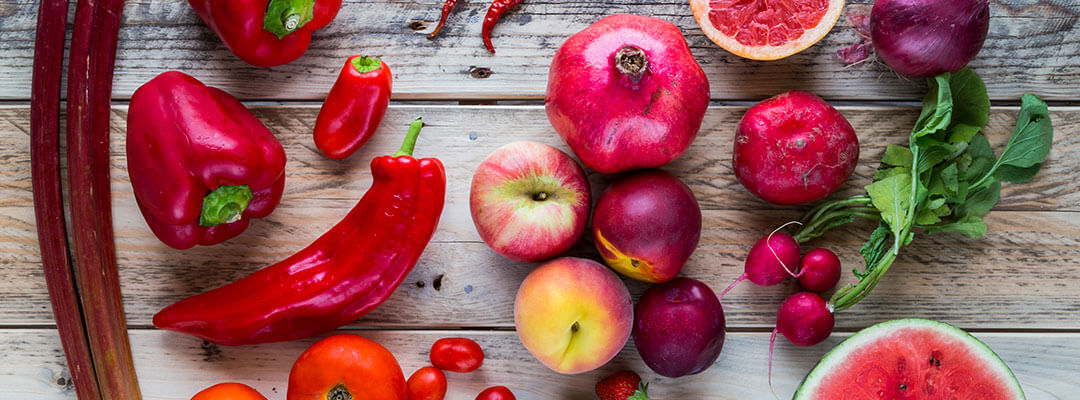When it comes to eating the rainbow, do red foods deserve that special spot at the top of the arch? Turns out they certainly do. Colorful foods are abundant in vitamins and minerals and are a nutrient-dense addition to any plate. However, the red pigment of red fruits and vegetables offers a special bang-for-your-buck in terms of health benefits, and we’ll explore this in more detail in today’s post.

Health Benefits of Eating Red Foods
Two plant pigments, anthocyanins and lycopene, are nature’s red food coloring and are responsible for making red foods red. They both come with a whole host of health benefits, in addition to providing the varying degrees of a ruby hue. Lycopene is an antioxidant known for its cancer-fighting properties, per Antioxidants in 2020. Anthocyanins contain antioxidants that fight free radicals and inflammation, according to a study published in Pharmaceuticals in 2021.
The list of the potential touted benefits of red foods is long and includes:
- Anti-cancer
- Anti-inflammatory
- Anti-diabetic
- Reduced free radicals
- Reduced risk of hypertension
- Reduced risk of high cholesterol
- Protecting organs and cells from damage
- Protection against heart disease
- Protecion against reproductive systems diseases
- Improved vision
- Improved brain function
- High in vitamins, minerals, and dietary fiber
Let’s dig in to some of the more specific health benefits of the top red foods.
12 Red Foods to Include in Your Diet
Red Vegetables:
Red Beets
The unique, earthy-sweet flavor of beets make them a pretty polarizing addition to the plate. Add in stained fingertips and dish towels, and many choose not to bother with the little bulbs. However, their health benefits as a dark red food are undeniable. Beets are unique in that a plant pigment called betalains, not lycopene or anthocyanins, is responsible for their rich jewel-tone color.
Red beets are one of the only edible sources of betalain, and are touted for increasing stamina and providing a rich source of folate. They contain high levels of nitrates, which lower blood pressure, and support gut health, which in turn fuels our immune system.
Tomatoes
While technically a fruit, very few people seem to enjoy making smoothies out of tomatoes. For all intents and purposes as a red food, they fall under the vegetable umbrella. Tomatoes are a rich source of lycopene and our primary source of the antioxidant. Lycopene, particularly from tomato sources, has been studied extensively.
A review published in 2013 described how lycopene reduces the risk of cancer, specifically prostate, lung, and stomach. Lycopene is also associated with a lower risk of cardiovascular disease due to a reduction in cholesterol synthesis and increased LDL degradation. This review also detailed a link between low lycopene levels and increased psychiatric disorders, as well as use as a potential asthma therapy.
Radishes
While not typically the star of any plate, it’s worth adding some of the peppery, crisp, bite-sized root vegetables to your diet. Red radishes are a potent source of anthocyanins. They contain several antioxidants and high levels of vitamin C. Radishes have been shown to help regulate blood sugar levels and reduce the risk of diabetes. They also aid in liver function and contain high levels of calcium and potassium, which have been linked to cardiovascular health.
Red Cabbage
There’s so much more to red cabbage, than simply adding color to your coleslaw. Red cabbage, also called purple cabbage, is a cruciferous vegetable with numerous health benefits. The leaves’ rich hue is due to high levels of anthocyanins, which benefit the heart. It’s a great source of dietary fiber and other antioxidants. Red cabbage has been linked to bone health, thanks to its higher levels of vitamin K and small amounts of bone-building minerals. The high fiber content of red cabbage is beneficial to your gut bacteria and overall digestive system health.
Red Onion
Red onions have a lot more to offer than their sharp bite and tangy taste. They get their deep red skin color from anthocyanins and are rich in quercetin, an antioxidant linked to immune health. Red onions have antibacterial properties and are a great source of prebiotics, which feed healthy gut bacteria and aid in microbiome health. Studies have shown intake may help maintain bone health and prevent osteoporosis.
Red Bell Peppers
When it comes to bell peppers, they have a rainbow in and of themselves. But it may behoove you to lean toward the red skin variety. Red peppers get their bright, poppy red color from lycopenes. They are a high source of vitamin C, which is helpful for boosting immune health. Red bell peppers offer a solid source of dietary fiber and their vitamin A content is great for vision health. Also worth an antioxidant nod are red chili peppers/red chilies.
Red Fruits:
Apples
An apple a day may keep the doctor away because the dark red peel of a red delicious is where most of the anthocyanins lie. And the riper and more mature the fruit is, the more antioxidants accumulate in the peel. Regularly consuming apples has been linked to a lower occurrence of breast cancer and cardiovascular disease, per Flavonoids, published in 2019.
Apples are also a great source of dietary fiber, they boost gut health, and provide a good source of vitamin C. They also contain quercetin, which may aid in the prevention of Alzheimer’s disease.
Cranberries
While their tart flavor may not be everyone’s favorite, it may be worth digging into the polarizing sour side dish at this year’s holiday celebration. Lycopene is responsible for the cranberry’s dark red skin, with its positive antioxidant properties spanning from lowering blood pressure, to preventing cardiovascular disease, to fighting inflammation.
Cranberries have been associated with the treatment of several ailments including, urinary tract infections, preventing tooth decay and may help slow the progression of cancer, per Medical News Today.
Watermelon
Everyone’s favorite summer poolside snack contains more lycopene than most other foods. According to the USDA, it contains 40 percent more of the antioxidant than raw tomatoes, and our bodies are able to absorb it from the melon just as well. The redder and riper the flesh, the more nutritious that slice is. Watermelon is also a great source of vitamin A, B6, and C.
Red Pear
Red pears have anthocyanins to thank for their skin shade. The levels of anthocyanins present in pears follows somewhat of a bell curve—peaking at about the middle stages of its ripeness and declining as the fruit continues to age, per a study published in 2019. Red pears are also chock full of vitamin C and potassium, and are an excellent source of dietary fiber, per Healthfully.
While not a pear per se, the prickly pear cactus plant is worth noting. According to ScienceDirect, it’s one of the few food sources, other than red beets, that is rich in betalains—a strong antioxidant.
Red Berries
Strawberry, raspberry, blackberries, red cherries, and red grapes are all rich in anthocyanins and deserve a spot in your fruit salad. The majority of the antioxidants are found in the berry’s skin. Anthocyanins from berries have been shown to affect cell growth—decreasing the formation of carcinogenic tumors, published in Superfood and Functional Food in 2017.
According to a review published in 2022, red and black grapes are the main dietary source of anthocyanins. And yes, that includes juice and red wine, though some anthocyanin concentration is typically lost in the processing of the fruit to beverage.
Pomegranate
Pomegranate seeds, peel, and their juice, contain high levels of anthocyanins and have powerful health benefits, including the prevention and treatment of osteoarthritis and rheumatoid arthritis as well as several types of cancer, including as breast and prostate. Pomegranate has also been shown to benefit the reproductive system and possibly offer antidiabetic effects.
Pomegranate juice is touted as offering greater antioxidant potential than both red wine and green tea. It’s worth raising a glass or popping a handful of seeds on your next salad.
Summary
Red foods of the rainbow are not just pretty to look at—they’re teeming with health benefits. Turns out nature knew what it was doing when it made that shiny, brightly colored skin of our favorite fruits and vegetables enticing. It shouldn’t be too hard to add any of the above delicious options to your plate from time-to-time to take advantage of the antioxidant punch they offer. If you’re looking for more guidance on adopting a healthier diet and lifestyle, a myPrimalCoach is ready to help you get started.

